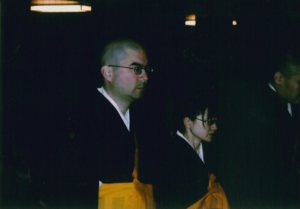It’s #throwbackthursday again! In this installment I wrote about my Dharma Name which I received at Tokudo, with some follow up thoughts from the years since – hard to believe it’s been over ten years!
February 29th, 2004
So I have a new name: Shaku Gyokyo 釋楽橋. When you get ordained, you are given a Dharma Name 法名 (homyo) – one that someone has selected for you or one you make up yourself. I made mine up.
My original idea was Dokyo 道橋, meaning “Bridge of the Tao/Path”, but there was a famous Korean monk with that already. Then I thought of using Hokyo 法橋, or “Bridge of the Dharma.” But finally I came up with Gyokyo. Kyo is the Chinese reading for “hashi” or bridge, which is my real last name. Gyo is a special Chinese reading for the character for “tanoshii”, or “enjoy”. It’s also “raku” from “anraku” 安楽 and “gokuraku” 極楽 (Land of Bliss/the Pure Land), and the “gaku” in “ongaku” 音楽, music. “Raku” by itself means comfortable or relaxed. The gyo reading comes from the term “shingyo” 信楽, “joyful entrusting” – this is another term for “shinjin” 信心 or “entrusting mind”, which is at the core of Jodo Shinshu Buddhism. The Shaku 釋 is found in every Dharma name, and comes from the name of Shakyamuni, indicating that one is a disciple of the Buddha.
When I think about it now, I guess I’m not sure how my Dharma name would translate. Bridge of Happiness? Bridge of Bliss? Bridge of Shinjin? Bridge of Comfort? I guess it’s all these things, I like it because it can have multiple meanings. I like music, I like the Pure Land, I like Shinjin, and I like comfort…
Some further thoughts:
I love my Dharma Name, but one thing I have realized is that it is really difficult for non-Japanese speakers to pronounce. The consonant followed immediately by the y and o just doesn’t happen in English. That’s why people pronounce Kyoto “ki-yo-to” or Tokyo “to-ki-o.” For instance, Deep Purple’s “My Woman From Tokyo” is sung “My Wo-man from To Kee Oh.”
Another thing is that if people know Buddhist terms and kanji, they often assume that the “gyo” is for “practice” (行) and “kyo” is “teaching” (教).
But if I could go back in time, I don’t think I would change it. It resonates with me, it has an obscure, especially Shinshu aspect (the “gyo” reading), and people that know Japanese tend to like it once they see the kanji. I’ll close with my favorite picture from my Tokudo – I am actually very fortunate to have this picture, one of my classmates had received Tokudo a few months previous so he knew the perfect spot to stand!


